Yang Ji
Beijing University of Posts and Telecommunications
Enhancing Job Salary Prediction with Disentangled Composition Effect Modeling: A Neural Prototyping Approach
Mar 17, 2025Abstract:In the era of the knowledge economy, understanding how job skills influence salary is crucial for promoting recruitment with competitive salary systems and aligned salary expectations. Despite efforts on salary prediction based on job positions and talent demographics, there still lacks methods to effectively discern the set-structured skills' intricate composition effect on job salary. While recent advances in neural networks have significantly improved accurate set-based quantitative modeling, their lack of explainability hinders obtaining insights into the skills' composition effects. Indeed, model explanation for set data is challenging due to the combinatorial nature, rich semantics, and unique format. To this end, in this paper, we propose a novel intrinsically explainable set-based neural prototyping approach, namely \textbf{LGDESetNet}, for explainable salary prediction that can reveal disentangled skill sets that impact salary from both local and global perspectives. Specifically, we propose a skill graph-enhanced disentangled discrete subset selection layer to identify multi-faceted influential input subsets with varied semantics. Furthermore, we propose a set-oriented prototype learning method to extract globally influential prototypical sets. The resulting output is transparently derived from the semantic interplay between these input subsets and global prototypes. Extensive experiments on four real-world datasets demonstrate that our method achieves superior performance than state-of-the-art baselines in salary prediction while providing explainable insights into salary-influencing patterns.
A Comprehensive Survey on Self-Interpretable Neural Networks
Jan 26, 2025Abstract:Neural networks have achieved remarkable success across various fields. However, the lack of interpretability limits their practical use, particularly in critical decision-making scenarios. Post-hoc interpretability, which provides explanations for pre-trained models, is often at risk of robustness and fidelity. This has inspired a rising interest in self-interpretable neural networks, which inherently reveal the prediction rationale through the model structures. Although there exist surveys on post-hoc interpretability, a comprehensive and systematic survey of self-interpretable neural networks is still missing. To address this gap, we first collect and review existing works on self-interpretable neural networks and provide a structured summary of their methodologies from five key perspectives: attribution-based, function-based, concept-based, prototype-based, and rule-based self-interpretation. We also present concrete, visualized examples of model explanations and discuss their applicability across diverse scenarios, including image, text, graph data, and deep reinforcement learning. Additionally, we summarize existing evaluation metrics for self-interpretability and identify open challenges in this field, offering insights for future research. To support ongoing developments, we present a publicly accessible resource to track advancements in this domain: https://github.com/yangji721/Awesome-Self-Interpretable-Neural-Network.
Contrastive Conditional Alignment based on Label Shift Calibration for Imbalanced Domain Adaptation
Dec 29, 2024Abstract:Many existing unsupervised domain adaptation (UDA) methods primarily focus on covariate shift, limiting their effectiveness in imbalanced domain adaptation (IDA) where both covariate shift and label shift coexist. Recent IDA methods have achieved promising results based on self-training using target pseudo labels. However, under the IDA scenarios, the classifier learned in the source domain will exhibit different decision bias from the target domain. It will potentially make target pseudo labels unreliable, and will further lead to error accumulation with incorrect class alignment. Thus, we propose contrastive conditional alignment based on label shift calibration (CCA-LSC) for IDA, to address both covariate shift and label shift. Initially, our contrastive conditional alignment resolve covariate shift to learn representations with domain invariance and class discriminability, which include domain adversarial learning, sample-weighted moving average centroid alignment and discriminative feature alignment. Subsequently, we estimate the probability distribution of the target domain, and calibrate target sample classification predictions based on label shift metrics to encourage labeling pseudo-labels more consistently with the distribution of real target data. Extensive experiments are conducted and demonstrate that our method outperforms existing UDA and IDA methods on benchmarks with both label shift and covariate shift. Our code is available at https://github.com/ysxcj-hub/CCA-LSC.
ContrastAlign: Toward Robust BEV Feature Alignment via Contrastive Learning for Multi-Modal 3D Object Detection
May 27, 2024



Abstract:In the field of 3D object detection tasks, fusing heterogeneous features from LiDAR and camera sensors into a unified Bird's Eye View (BEV) representation is a widely adopted paradigm. However, existing methods are often compromised by imprecise sensor calibration, resulting in feature misalignment in LiDAR-camera BEV fusion. Moreover, such inaccuracies result in errors in depth estimation for the camera branch, ultimately causing misalignment between LiDAR and camera BEV features. In this work, we propose a novel ContrastAlign approach that utilizes contrastive learning to enhance the alignment of heterogeneous modalities, thereby improving the robustness of the fusion process. Specifically, our approach includes the L-Instance module, which directly outputs LiDAR instance features within LiDAR BEV features. Then, we introduce the C-Instance module, which predicts camera instance features through RoI (Region of Interest) pooling on the camera BEV features. We propose the InstanceFusion module, which utilizes contrastive learning to generate similar instance features across heterogeneous modalities. We then use graph matching to calculate the similarity between the neighboring camera instance features and the similarity instance features to complete the alignment of instance features. Our method achieves state-of-the-art performance, with an mAP of 70.3%, surpassing BEVFusion by 1.8% on the nuScenes validation set. Importantly, our method outperforms BEVFusion by 7.3% under conditions with misalignment noise.
Decoupled Federated Learning on Long-Tailed and Non-IID data with Feature Statistics
Mar 13, 2024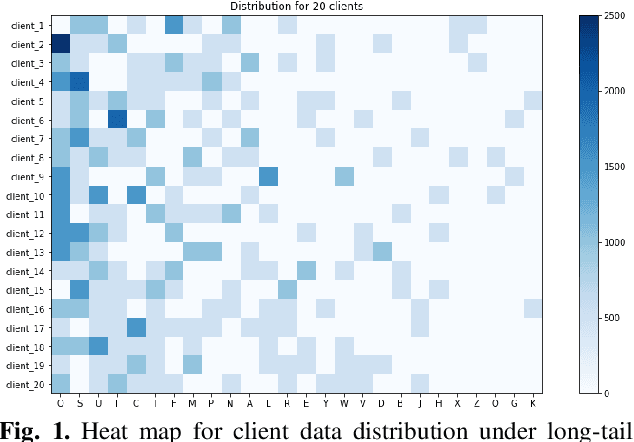
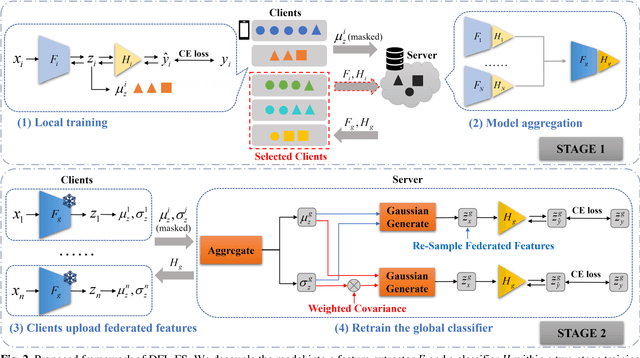

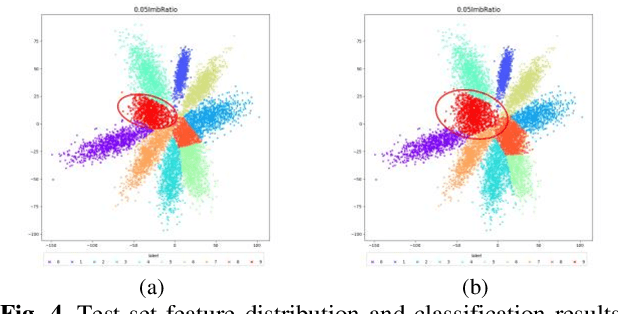
Abstract:Federated learning is designed to enhance data security and privacy, but faces challenges when dealing with heterogeneous data in long-tailed and non-IID distributions. This paper explores an overlooked scenario where tail classes are sparsely distributed over a few clients, causing the models trained with these classes to have a lower probability of being selected during client aggregation, leading to slower convergence rates and poorer model performance. To address this issue, we propose a two-stage Decoupled Federated learning framework using Feature Statistics (DFL-FS). In the first stage, the server estimates the client's class coverage distributions through masked local feature statistics clustering to select models for aggregation to accelerate convergence and enhance feature learning without privacy leakage. In the second stage, DFL-FS employs federated feature regeneration based on global feature statistics and utilizes resampling and weighted covariance to calibrate the global classifier to enhance the model's adaptability to long-tailed data distributions. We conducted experiments on CIFAR10-LT and CIFAR100-LT datasets with various long-tailed rates. The results demonstrate that our method outperforms state-of-the-art methods in both accuracy and convergence rate.
centroIDA: Cross-Domain Class Discrepancy Minimization Based on Accumulative Class-Centroids for Imbalanced Domain Adaptation
Aug 21, 2023Abstract:Unsupervised Domain Adaptation (UDA) approaches address the covariate shift problem by minimizing the distribution discrepancy between the source and target domains, assuming that the label distribution is invariant across domains. However, in the imbalanced domain adaptation (IDA) scenario, covariate and long-tailed label shifts both exist across domains. To tackle the IDA problem, some current research focus on minimizing the distribution discrepancies of each corresponding class between source and target domains. Such methods rely much on the reliable pseudo labels' selection and the feature distributions estimation for target domain, and the minority classes with limited numbers makes the estimations more uncertainty, which influences the model's performance. In this paper, we propose a cross-domain class discrepancy minimization method based on accumulative class-centroids for IDA (centroIDA). Firstly, class-based re-sampling strategy is used to obtain an unbiased classifier on source domain. Secondly, the accumulative class-centroids alignment loss is proposed for iterative class-centroids alignment across domains. Finally, class-wise feature alignment loss is used to optimize the feature representation for a robust classification boundary. A series of experiments have proved that our method outperforms other SOTA methods on IDA problem, especially with the increasing degree of label shift.
Dual-Branch Temperature Scaling Calibration for Long-Tailed Recognition
Aug 16, 2023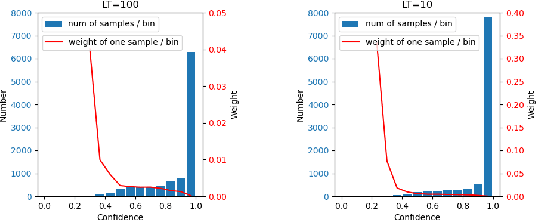

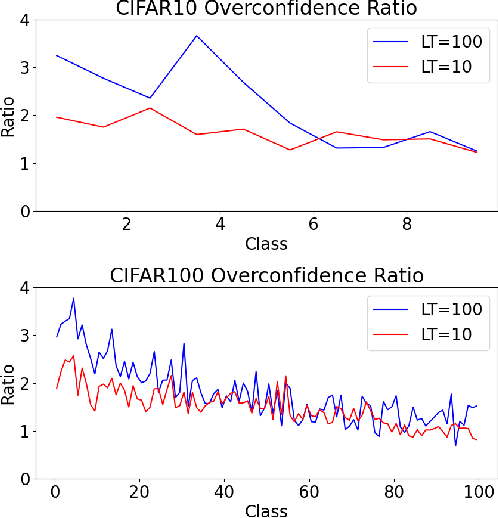

Abstract:The calibration for deep neural networks is currently receiving widespread attention and research. Miscalibration usually leads to overconfidence of the model. While, under the condition of long-tailed distribution of data, the problem of miscalibration is more prominent due to the different confidence levels of samples in minority and majority categories, and it will result in more serious overconfidence. To address this problem, some current research have designed diverse temperature coefficients for different categories based on temperature scaling (TS) method. However, in the case of rare samples in minority classes, the temperature coefficient is not generalizable, and there is a large difference between the temperature coefficients of the training set and the validation set. To solve this challenge, this paper proposes a dual-branch temperature scaling calibration model (Dual-TS), which considers the diversities in temperature parameters of different categories and the non-generalizability of temperature parameters for rare samples in minority classes simultaneously. Moreover, we noticed that the traditional calibration evaluation metric, Excepted Calibration Error (ECE), gives a higher weight to low-confidence samples in the minority classes, which leads to inaccurate evaluation of model calibration. Therefore, we also propose Equal Sample Bin Excepted Calibration Error (Esbin-ECE) as a new calibration evaluation metric. Through experiments, we demonstrate that our model yields state-of-the-art in both traditional ECE and Esbin-ECE metrics.
Multi-Factors Aware Dual-Attentional Knowledge Tracing
Aug 10, 2021Abstract:With the increasing demands of personalized learning, knowledge tracing has become important which traces students' knowledge states based on their historical practices. Factor analysis methods mainly use two kinds of factors which are separately related to students and questions to model students' knowledge states. These methods use the total number of attempts of students to model students' learning progress and hardly highlight the impact of the most recent relevant practices. Besides, current factor analysis methods ignore rich information contained in questions. In this paper, we propose Multi-Factors Aware Dual-Attentional model (MF-DAKT) which enriches question representations and utilizes multiple factors to model students' learning progress based on a dual-attentional mechanism. More specifically, we propose a novel student-related factor which records the most recent attempts on relevant concepts of students to highlight the impact of recent exercises. To enrich questions representations, we use a pre-training method to incorporate two kinds of question information including questions' relation and difficulty level. We also add a regularization term about questions' difficulty level to restrict pre-trained question representations to fine-tuning during the process of predicting students' performance. Moreover, we apply a dual-attentional mechanism to differentiate contributions of factors and factor interactions to final prediction in different practice records. At last, we conduct experiments on several real-world datasets and results show that MF-DAKT can outperform existing knowledge tracing methods. We also conduct several studies to validate the effects of each component of MF-DAKT.
* 10 pages, 10 figures, 6 tables
An Adaptive Oversampling Learning Method for Class-Imbalanced Fault Diagnostics and Prognostics
Nov 19, 2018



Abstract:Data-driven fault diagnostics and prognostics suffers from class-imbalance problem in industrial systems and it raises challenges to common machine learning algorithms as it becomes difficult to learn the features of the minority class samples. Synthetic oversampling methods are commonly used to tackle these problems by generating the minority class samples to balance the distributions between majority and minority classes. However, many of oversampling methods are inappropriate that they cannot generate effective and useful minority class samples according to different distributions of data, which further complicate the process of learning samples. Thus, this paper proposes a novel adaptive oversampling technique: EM-based Weighted Minority Oversampling TEchnique (EWMOTE) for industrial fault diagnostics and prognostics. The methods comprises a weighted minority sampling strategy to identify hard-to-learn informative minority fault samples and Expectation Maximization (EM) based imputation algorithm to generate fault samples. To validate the performance of the proposed methods, experiments are conducted in two real datasets. The results show that the method could achieve better performance on not only binary class, but multi-class imbalance learning task in different imbalance ratios than other oversampling-based baseline models.
 Add to Chrome
Add to Chrome Add to Firefox
Add to Firefox Add to Edge
Add to Edge